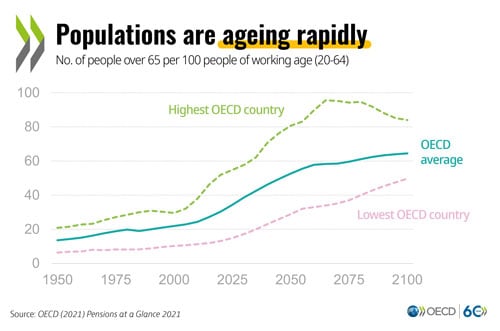
|
|
Future
pension entitlements have also been well protected thanks to the
exceptional policy response to the crisis, according to a new OECD
report.
Pensions at a Glance 2021
says however that the long-term financial pressure from ageing
persists. Pension finances deteriorated during the pandemic due to lost
contributions, and shortfalls have been mainly covered by state budgets.
Putting pensions systems on a solid footing for the future will require
painful policy decisions,
 Although
life expectancy gains in old age have slowed since 2010, the pace of
ageing is projected to be fast over the next two decades. The size of
the working-age population is projected to fall by more than one‑quarter
by 2060 in most Southern, Central and Eastern European countries as
well as in Japan and Korea.
Although
life expectancy gains in old age have slowed since 2010, the pace of
ageing is projected to be fast over the next two decades. The size of
the working-age population is projected to fall by more than one‑quarter
by 2060 in most Southern, Central and Eastern European countries as
well as in Japan and Korea.
Young people have been severely affected by the crisis and might see
their future benefits lowered, especially if the pandemic results in
longer-term scarring and difficulties in building their careers.
Allowing early access to pension savings to compensate for economic
hardship, as observed in some countries such as Chile, may also generate
long-term problems: unless future higher savings offset these
withdrawals, low retirement benefits will be the consequence.
Mandatory schemes provide an average future net replacement rate of
62% to full-career average‑wage workers, ranging from less than 40% in
Chile, Estonia, Ireland, Japan, Korea, Lithuania and Poland to 90% or
more in Hungary, Portugal and Turkey.
Over the last two years, many countries significantly reformed
earnings-related pension benefits, including Estonia, Greece, Hungary,
Mexico, Poland and Slovenia. Chile, Germany, Latvia and Mexico also
increased income protection for low earners. Action on retirement ages
was limited. Sweden increased the minimum retirement age for public
earnings-related pensions; the Netherlands postponed the planned
increase while reducing the pace of the future link to life expectancy;
and Ireland repealed the planned increase from 66 to 68 years. Denmark,
Ireland, Italy and Lithuania have extended early retirement options.
Based on legislated measures, the normal retirement age will increase
by about two years in the OECD on average by the mid‑2060s. The future
normal retirement age is 69 years or more in Denmark, Estonia, Italy and
the Netherlands, while Colombia, Luxembourg and Slovenia will let men
retire at 62. Women will maintain a lower normal retirement age than men
in Colombia, Hungary, Israel, Poland and Switzerland.
Pensions at a Glance 2021 says that the biggest long-term challenge
for pensions continues to be providing financially and socially
sustainable pensions in the future. Many countries have introduced
automatic adjustment mechanisms (AAM) in their pension systems that
change pension system parameters, such as pension ages, benefits or
contribution rates, when demographic, economic or financial indicators
change. These automatic adjustment mechanisms are crucial to help deal
with the impact of ageing.
About two‑thirds of OECD countries use some form of AAM
in their pension schemes, adjusting retirement ages, benefit levels and
contribution rates and using an automatic balancing mechanism. OECD
analysis shows that, over the years, the automatic adjustment mechanisms
were sometimes suspended or even eliminated in order to avoid pension
benefit cuts and retirement-age increases. Yet, compared to the
alternative of discretionary changes, AAMs can be designed and
implemented to generate changes that are less erratic, more transparent
and more equitable across generations.